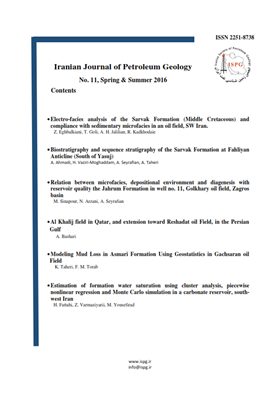Modeling Mud Loss in Asmari Formation Using Geostatistics in RMS Software Environment in an Oil Field in Southwestern Iran
Subject Areas : Petroleum Reservoir Geology
Kioumars Taheri
1
![]() ,
Farhad Mohammad Torab
2
,
Farhad Mohammad Torab
2
1 - M.Sc. in Petroleum Engineering Exploration, Department of Mining and Metallurgical Engineering, Yazd University, Yazd, Iran
2 - Associate Professor, Department of Mining and Metallurgical Engineering, Yazd University, Yazd, Iran
Keywords: Mud lossLost circulation predictionGeostatistical modelingRMS software ,
Abstract :
Studying lost circulation in Asmari formation is very important because about 25% to 40% of drilling costs is allocated to drilling mud expenses. Considering that Studied oil field encounters severe mud loss in Asmari formation, therefore the purpose of this study is recognition of the lost circulation zones and illustrating the mud loss distribution in Asmari formation. The mud loss maps in Asmari field were plotted in RMS software using moving average algorithm method. For this purpose, the data of 363 wells in this oil field was processed after data preparation, for mapping and 3D modeling of 11 different zones in Asmari formation. The data processing includes different stages such as elimination of outliers, normal transformation, drawing the histogram, variography and estimation and modeling. In this research, the geostatistical kriging method was also used for estimation and 3D modeling of mud loss in Asmari formation so that the output of geostatistical modeling method shows the localized and better results. Consequently, by applying and analysis of results, the 2D and 3D models of mud loss in Asmari formation were demonstrated. By simulation and modeling of mud loss and its comparison with reservoir fault modeling and production indexes plots, it was identified that the dominant mud losses are related to fault zone fractures and in minor cases the increasing of mud weight is the reason of mud loss. Applying appropriate operations such as under balance drilling (UBD) and suitable well placement, use of drilling mud with proper mud weight in severe mud loss points, use of NIF and MMH especial drilling muds with lowest formation damage, or a combination of these methods are suggested for mud loss control in critical points of the oil field.
[1] چیت فروش، ا.، مکوندی، ع.، همایی، م.، 1388، "ساخت مدل سه بعدی زمین شناسی مخزن آسماری میدان مورد مطالعه"، گزارش پ شماره 6621، مدیریت امور فنی، بایگانی زمین شناسی گسترشی، ص 170#
[2] چیت فروش، ا.، مکوندی، ع.، همایی، م.، سراج، م.، 1391، "مطالعه جامع مخازن آسماری و بنگستان میدان مورد مطالعه، بخش شکستگی¬ها"، گزارش پ شماره 8062، مدیریت امور فنی- بایگانی زمین شناسی گسترشی، ص 450#
[3] حسنی پاک، ع، ا.، 1392، "زمین آمار" انتشارات دانشگاه تهران، ص 328#
[4] عباسيان، م.، 1361، مطالعه شكستگي¬هاي مخزن آسماري ميدان مورد مطالعه، گزارش شماره پ-3796، مناطق نفتخيز جنوب، شركت ملي نفت ايران، اهواز، ایران، ص 120#
[5] گروه مطالعه جامع میدان مورد بررسی، 1392، "چاه آزمايي(مخازن آسماري و بنگستان) میدان، فاز تعیین مشخصات مخزن" گزارش پ شماره 7403، مدیریت امور فنی- بایگانی مهندسی نفت، عملیات چاه آزمایی، ص 174#
[6] مجیدی، ر.، استفان، ل.، جرارد، ت، ژ.، 1389،" مدلسازی تلفات گل حفاری در سازند به طور طبیعی شکسته "، کنفرانس سالانه انجمن نفت امریکا، دنور، کلرادو، ایالات متحده آمریکا#
Ahmed, T., 2010, ”Reservoir Engineering Handbook”, Fourth Edition, Publishing Elsevier, pp 1454[7]#
[8] Barker, S, N., 1978, “Study Field, Asmari Reservoir Fracture System” Geology Report, Report P-Number 3561, NISOC, pp 30.#
[9] Beicip Franlab, Co., and Tehran Energy., 2006, “Study of the Asmari-Bangestan Res, Study Field,” Geology Report, Report P-Number 3185, NISOC, pp 150.#
[10] Civan, F., 2000، “Reservoir Formation Damage”, Gulf Publishing Company Huoston, Texas, pp 745.#
[11] Edward Hohn, M., 2013,” Geostatistics and Petroleum Geology”,pp 224.#
[12] Li, H., and White, C. D., 2003, “Geostatistical Shale Models for a Deltaic Reservoir Analog: From 3D GPR Data to 3D Flow Modeling”, The Department of Petroleum Engineering, Louisiana State University and Agriculture and Mechanical College, May 11-14, pp 15.#
[13] Petresim, Co., 1993, “Study Field, Geology of Asmari Reservoir” Geology Report, Report P-Number 3161, NISOC, pp 140.#
[14] Roxar, Co., 2008, Irap RMS Maintenance Release User Guide, Roxar Software Solutions Gamle Forusvei, PP 2335.#
[15]Spear, R, G., Barker, S, N., 1977, “Study Field, Geology of Asmari Reservoir” Geology Report, Report P-Number 3171, NISOC, pp 40.#


